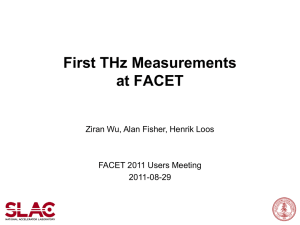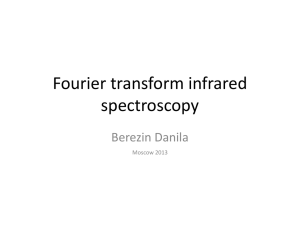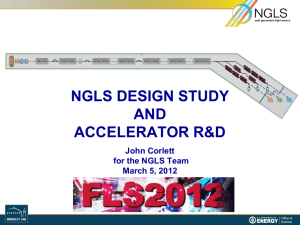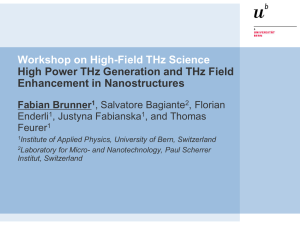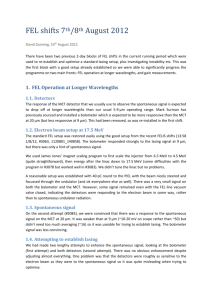Project summaries (2012-07)
advertisement
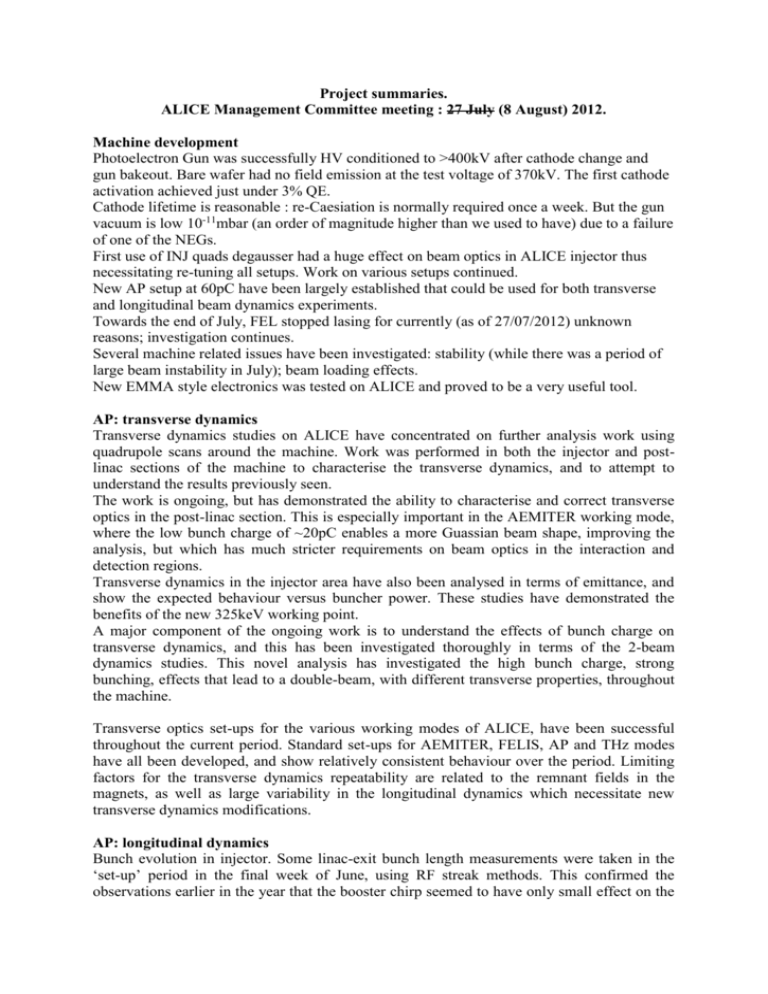
Project summaries. ALICE Management Committee meeting : 27 July (8 August) 2012. Machine development Photoelectron Gun was successfully HV conditioned to >400kV after cathode change and gun bakeout. Bare wafer had no field emission at the test voltage of 370kV. The first cathode activation achieved just under 3% QE. Cathode lifetime is reasonable : re-Caesiation is normally required once a week. But the gun vacuum is low 10-11mbar (an order of magnitude higher than we used to have) due to a failure of one of the NEGs. First use of INJ quads degausser had a huge effect on beam optics in ALICE injector thus necessitating re-tuning all setups. Work on various setups continued. New AP setup at 60pC have been largely established that could be used for both transverse and longitudinal beam dynamics experiments. Towards the end of July, FEL stopped lasing for currently (as of 27/07/2012) unknown reasons; investigation continues. Several machine related issues have been investigated: stability (while there was a period of large beam instability in July); beam loading effects. New EMMA style electronics was tested on ALICE and proved to be a very useful tool. AP: transverse dynamics Transverse dynamics studies on ALICE have concentrated on further analysis work using quadrupole scans around the machine. Work was performed in both the injector and postlinac sections of the machine to characterise the transverse dynamics, and to attempt to understand the results previously seen. The work is ongoing, but has demonstrated the ability to characterise and correct transverse optics in the post-linac section. This is especially important in the AEMITER working mode, where the low bunch charge of ~20pC enables a more Guassian beam shape, improving the analysis, but which has much stricter requirements on beam optics in the interaction and detection regions. Transverse dynamics in the injector area have also been analysed in terms of emittance, and show the expected behaviour versus buncher power. These studies have demonstrated the benefits of the new 325keV working point. A major component of the ongoing work is to understand the effects of bunch charge on transverse dynamics, and this has been investigated thoroughly in terms of the 2-beam dynamics studies. This novel analysis has investigated the high bunch charge, strong bunching, effects that lead to a double-beam, with different transverse properties, throughout the machine. Transverse optics set-ups for the various working modes of ALICE, have been successful throughout the current period. Standard set-ups for AEMITER, FELIS, AP and THz modes have all been developed, and show relatively consistent behaviour over the period. Limiting factors for the transverse dynamics repeatability are related to the remnant fields in the magnets, as well as large variability in the longitudinal dynamics which necessitate new transverse dynamics modifications. AP: longitudinal dynamics Bunch evolution in injector. Some linac-exit bunch length measurements were taken in the ‘set-up’ period in the final week of June, using RF streak methods. This confirmed the observations earlier in the year that the booster chirp seemed to have only small effect on the linac-exit bunch length for the current injector set-up. This is somewhat unexpected and further data/simulations are required to understand the effect. Path length Measurements. Time of flight measurements have continued using high resolution oscilloscope and BPM signals. These have demonstrated the ability to measure TOF differences to a couple of pico seconds and thus can measure in principle R56 values of ~ cm level. The effect of lattice tuning including arc quadrupole and sextuple strength on the time of flight has been measured, but the repeatability of the results and comparison with theoretical expectation is not clear and work is underway to understand the experimental artefacts involved in the method. Elegant simulations have shows some agreement with the data on the shape of the TOF vs energy curve and the influence of arc sextupole. Single Bunch BPMs. Primarily to aid the understanding of the path length measurements, single bunch BPM electronics have been used on the arc BPMs. These have provided information on the energy of the bunches over the train and the alignment of the magnets in the arc. In particular they are useful to understand the offset of the beam in the sextupoles which is crucial to longitudinal dynamics. 2 scheduled AP shifts were lost to RF faults on Sun 1st of July. FEL FEL lasing was restored very early in the running period after the cathode change (in the first full shift). A reasonable setup was established with similar power levels to previous running periods, however the performance in terms of stability has been mixed – a few shifts with high stability but more often not so good. This has been a cross-machine problem and the FEL has been used to investigate the source of the instability, in addition to working to improve the tolerance of the FEL setup to instability. Further work is required on improving the setup – particularly since some recent changes have made restoring lasing problematic. A fast-response detector was installed in the accelerator hall and has been used to resolve individual pulses in the FEL output. Data was recorded to evaluate the gain of the FEL, with the intention for this detector to be used in future as an online diagnostic of FEL performance. A laser used for monitoring the FEL cavity mirror angles had failed and has been replaced. A new aim for the project is to demonstrate lasing at 20um (a particularly useful wavelength for scientific studies using the output), which requires a new electron beam setup at lower energy. A few attempts have been scheduled but not completed due to various difficulties, so this remains a priority for future shifts. A detector sensitive to this wavelength has been sourced and installed. One other significant development is that several non-FEL-specialist members of the commissioning team have successfully established lasing in this period. This increases the potential for utilising the FEL in conjunction with other accelerator physics projects, plus providing additional support for FEL-user projects such as FELIS. EMMA "EMMA had beam time for three days from 16 to 18 July. A beam in EMMA seemed very good or even better than ever before probably because of careful tuning by JJ and/or more stable operation of ALICE. We spent shifts for two subjects. One is the investigation of EPICS/BPM system and the other is the COD analysis. Unfortunately, the EPICS/BPM system is still not fully functioning. In order to pin down where the faults occurs, GC and Richard Burrell who is a designer of the digital system from a company spent large fraction of time. It suggested some improvement scenario to be tested later. Regarding the COD analysis, DK, IK and JG took a response function by moving a couple of magnets transversely. Hopefully, the detailed analysis of this pilot measurement will fix the parameters to be used for the response function measurement of the entire magnets." AEMITR Last year, we reached the stage of running some full system tests (including THz generation in the accelerator area, achieving the required electron beam optics, and operating all the diagnostics). The results we obtained showed (as we suspected) a level of beam size jitter that could make it difficult to identify the signal we are looking for (a variation in beam size in the chicane, indicating an increased energy spread resulting from interaction with the THz pulse). Although we could in principle average over many pulses to try to improve the effective signal-to-noise ratio, the problem is that our previous timing technique only enabled us to synchronise the electron and THz pulses to within (roughly) a nanosecond, whereas the electron beam is a couple of picoseconds, and the THz pulse perhaps less than that. This means we need to make long timing scans while looking for a signal, which already takes a considerable time, even without averaging. To try to improve our sensitivity to what we expect to be a rather small signal, we are working on two significant modifications to the set-up: 1. Using fast gated cameras in the chicane, we should be able to record YAG images from two bunches within the same train. We expect that the variation in beam size between bunches in the same train should be significantly smaller than the variation in bunches from different trains; therefore, by looking for differences between bunches within the same train we should achieve much better sensitivity to the THz interaction. 2. Use of the streak camera to synchronise the THz and electron bunches to within a few picoseconds. This will enable us to concentrate our search in regions where we have a much better confidence that the interaction should be. In the shifts we have had so far this year, the operation of the gated cameras for observing different bunches within a single train has been demonstrated. Initial attempts to use the streak camera identified some optics issues (to do with directing and focusing the image from the OTR screen onto the camera), which should be resolved with some further work. At the same time, continued experiments with THz production in the Diagnostics Room have given a better understanding of the properties of the THz beam, including the focusing required to produce an observable effect on the electron beam. The goal is to demonstrate an energy modulation on the electron beam by interaction with the THz pulse, by the end of this year. FELIS First snom beamtime in July allowed re-installing the microscope and testing improved data acquisition systems which include incident flux normalisation. Some beam instability in the first part of the beamtime gave opportunity for this to be tested and the expected improvement in snom images were obtained by normalising to the incident flux. A short amount of time was used to try to improve the coupling of light from the fibre onto the MCT detector element but this will now be perused off line using a broadband thermal source. The SNOM tip was used to collect the reflected IR light as a function of wavelength for standard samples and for one tissue sample at various points on each of the samples. The local absorption is a small component of the total snom signal and a better understanding of basic physics of the snom process will now be a major component of a more focussed EPSRC proposal by PW. THz High levels of THz were generated and transmitted to the diagnostics room during start up. Although beamline transmission dropped for the exploitation slot on 15 July, Martin Volk was still able to obtain data from peptides in solution as a function of temperature, using a custom cell with TPX windows. Another microfluidic cell equipped with silicon windows was tested but found to cut out much more light. This will now be modify and the experiment re-run on 28 July. A coupler on the THz M1 mirror drive has failed, preventing use of the AP THz detector. This has now been repaired and the beamline will be reoptimised on 28 July prior to THz experiments. THz CTR A small nickel coated silicon screen is in place in the machine and a small breadboard for test detectors in place for initial tests of THz generation by CTR. A larger screen and appropriate holder are now available for future installation.



